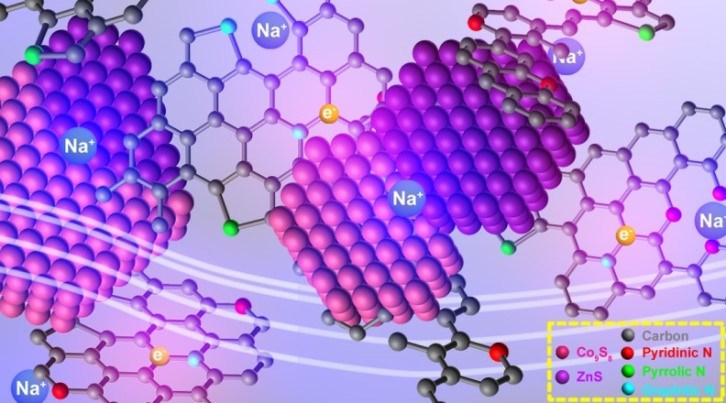Recently, two international top energy journalsAdvanced Energy Materials(IF=16.72) andEnergy Storage Materials(IF≈12) and the Nature Index journalChemical Communicationshave published online in succession the serial research findings of the team led by Prof. Liang Shuquan of the School of Materials Science and Engineering of SCU in the fields of sodium-ion battery and aqueous zinc-ion battery.
Based on the preliminary team work, Fang Guozhao, one of the Top Ten Doctoral Candidates of CSU, and Special-term Professor Zhou Jiang successfully developed, with bi-metal MOFs as framework, an N-doped carbon-coated bi-metal sulfide used at the negative electrode of sodium-ion battery, effectively solving the bottleneck problems of negative electrode materials such as slow ion diffusion and volume expansion during charge and discharge. The total battery made with bi-metal sulfide and sodium vanadium phosphate is able to run 500 circles with capacity retention ratio up to 93%, making a significant breakthrough in the cathode material of sodium-ion battery. The research findings have been recently published on the international top energy journalAdvanced Energy Materials(Adv. Energy Mater., 2018, DOI: 10.1002/aenm.201703155) (IF=16.72). Special-term Professor Zhou Jiang, Prof. Pan Anqiang, Prof. Liang Shuquan of the School of Materials Science and Engineering of CSU are joint corresponding authors of the paper and CSU is the sole corresponding unit.

Cai Yangsheng, a winner of the President's Scholarships for Outstanding Doctoral Students of CSU, and Special-term Professor Zhou Jiang designed a new technology and developed a graphene-coated Na1.1V3O7.9composite material with stable felty texture in the research filed of aqueous zinc-ion battery, another hot spot of nano energy, remarkably improving the conductivity of the material and effectively relieving the stress and volume change of the material during intercalation and deintercalation of ions. It is the first time that sodium vanadate has been applied in the aqueous zinc-ion battery to realize excellent cyclic stability, which is of great guiding significance on the development of anode material of such battery. Related research findings are published in the international top energy journalEnergy Storage Materials(Energy Storage Mater., 2018, 13: 168-174) (IF≈12). Besides, the progress of the team’s fundamental research on using nano material V2O5as anode material of aqueous zinc-ion battery has been published in the Nature Index journalChemical Communication(Chem. Commun., 2018, DOI: 10.1039/C8CC02250J). Special-term Professor Zhou Jiang and Prof. Liang Shuquan are joint corresponding authors of the two papers and CSU is the sole corresponding unit.
Supported by “National Natural Science Foundation of China” and the original “863 Program”, middle-aged and young experts of the Nano Energy R&D Team of the School of Materials Science and Engineering have focused on the key problems in the new field of nano energy, made continuous exploration and innovation, and published in succession multiple influential (IF>10) and ESI highly cited papers in top journals of that field such asEnergy & Environmental Science,Advanced Energy MaterialsandNano Energy. The team’s paper on transformation and application of MOFs has recently become an ESI highly cited paper ofNano Energy(IF=12.34,DOI: 10.1016/j.nanoen.2016.05.009), cover paper ofJ. Mater. Chem. A(IF=8.86, DOI: 10.1039/c7ta01961k), and ESI highly cited paper ofACS Appl. Mater. Interfaces(DOI: 10.1021/acsami.6b13153).
Links to related papers:
https://onlinelibrary.wiley.com/doi/pdf/10.1002/aenm.201703155
https://www.sciencedirect.com/science/article/pii/S2405829717307213
http://pubs.rsc.org/en/content/articlelanding/2018/cc/c8cc02250j#!divAbstract
https://www.sciencedirect.com/science/article/pii/S2211285516301318
http://pubs.rsc.org/-/content/articlehtml/2017/ta/c7ta01961k
https://pubs.acs.org/doi/abs/10.1021/acsami.6b13153
Source: School of Materials Science and Engineering











